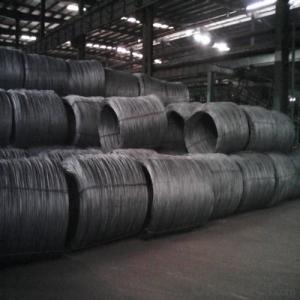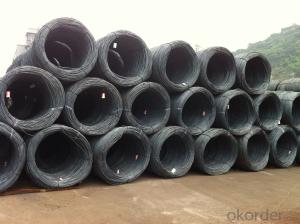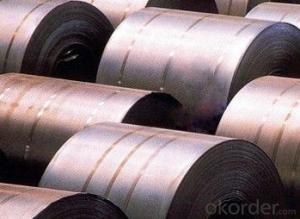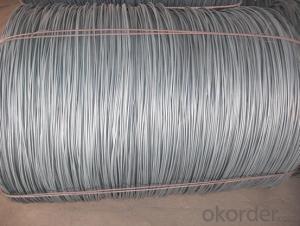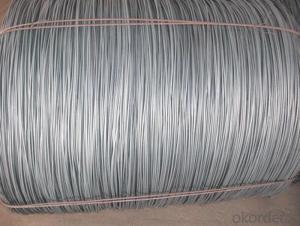Carbon Steel Hot Rolled Wire Rod SAE1008 SAE1006 SAE1018
- Loading Port:
- Tianjin
- Payment Terms:
- TT or LC
- Min Order Qty:
- 50 m.t.
- Supply Capability:
- 40000 m.t./month
OKorder Service Pledge
OKorder Financial Service
You Might Also Like
Product Description:
OKorder is offering Carbon Steel Hot Rolled Wire Rod SAE1008 SAE1006 SAE1018 at great prices with worldwide shipping. Our supplier is a world-class manufacturer of steel, with our products utilized the world over. OKorder annually supplies products to European, North American and Asian markets. We provide quotations within 24 hours of receiving an inquiry and guarantee competitive prices.
Product Applications:
Carbon Steel Hot Rolled Wire Rod SAE1008 SAE1006 SAE1018 are ideal for structural applications and are widely used in the construction of buildings and bridges, and the manufacturing, petrochemical, and transportation industries.
Product Advantages:
OKorder's Carbon Steel Hot Rolled Wire Rod SAE1008 SAE1006 SAE1018 are durable, strong, and resist corrosion.
Main Product Features:
· Premium quality
· Prompt delivery & seaworthy packing (30 days after receiving deposit)
· Corrosion resistance
· Can be recycled and reused
· Mill test certification
· Professional Service
· Competitive pricing
Product Specifications:
Specifications of Wire Rod SAE1008B:
Steel Grade: SAE1008B Standard: ASTM, GB
Diameter: 5.5mm, 6.5mm, 7mm,8mm,9mm,10mm,12mm,14mm
Type: Drawn Wire Alloy or Not: Alloy Brand Name: N-RIVER
Technique: Hot Rolled Place of Origin: China Mainland
Chemical Composition:
Please kindly find our chemistry of our material based on SAE1008B as below for your information
Grade | Chemical Composition (%) | |||||
C | Mn | S | P | Si | B | |
SAE1008B | 0.10max | 0.32max | 0.045max | 0.040max | 0.30max | 0.0008min |
Mechanical properties | ||||||
Yield strength(N/mm2) | Tensile strength(N/mm2) | Elongation (%) | ||||
≥195 | 350-380 | ≥32 | ||||
Usage and Applications of Wire Rod SAE1008B:
After hot-rolled the products shaped into coil and delivery as finished product, including round, square, rectangular, hexagonal and so on. Since most of the products are round, it is generally called wire rod. Carbon steel wire rod is widely used in construction and manufacturing. Carbon steel wire rod is mainly used for reinforcement of reinforced concrete and welded structure or reprocessed (roberts , nail, etc.) materials, especially used to produce wire drawing, welding electrode, nails, spring, electronic, precise machinery parts and so on.
Production Process of Wire Rod SAE1008B:
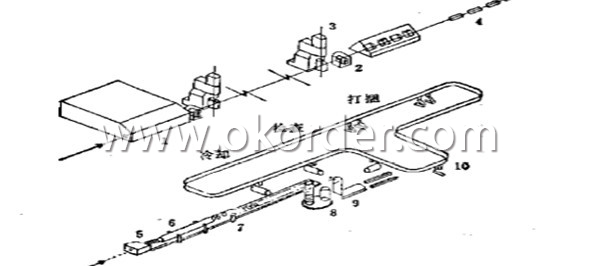
1-Furnace 2-Roughing Mill 3-High-speed Finishing Mill 4-Water-cooled Device 5-Coiling Device
6-Cooling Device 7-Chain Conveyer 8-Spool Collecting Device 9-Spool Down Device 10-Hook Conveyer
Packaging & Delivery of Wire Rod SAE1008B:
Packaging Detail: products are packed in coil and then shipped by container or bulk vessel
Each coil weight: 2-3MT
Delivery Detail: within 45 days after received deposit or LC.
Label: to be specified by customer, generally, each bundle has 1-2 labels
Trade terms: CFR, CIF
Note:
1. Our products are produced according to national standard (GB), if not, supply according to national standards (GB) or agreement as customer required.
2. Other Grade and Standard carbon steel wire rod we can supply:
Grade: H08A, 30MnSi, 62B-82B
Standard: AISI, BS, JIS, DIN
The Minimum Order Quantity of these products is high, and need to be confirmed.
3. We can not only supply carbon steel wire rod; if you need anything about building materials, please contact us.
4. Please send us your detail specifications when inquire. We will reply to you as soon as possible. We sincerely hope we can establish a long stable business relationship.
FAQ:
Q1: Why buy Materials & Equipment from OKorder.com?
A1: All products offered byOKorder.com are carefully selected from China's most reliable manufacturing enterprises. Through its ISO certifications, OKorder.com adheres to the highest standards and a commitment to supply chain safety and customer satisfaction.
Q2: How do we guarantee the quality of our products?
A2: We have established an advanced quality management system which conducts strict quality tests at every step, from raw materials to the final product. At the same time, we provide extensive follow-up service assurances as required.
Q3: How soon can we receive the product after purchase?
A3: Within three days of placing an order, we will begin production. The specific shipping date is dependent upon international and government factors, but is typically 7 to 10 workdays.
Q4: What makes stainless steel stainless?
A4: Stainless steel must contain at least 10.5 % chromium. It is this element that reacts with the oxygen in the air to form a complex chrome-oxide surface layer that is invisible but strong enough to prevent further oxygen from "staining" (rusting) the surface. Higher levels of chromium and the addition of other alloying elements such as nickel and molybdenum enhance this surface layer and improve the corrosion resistance of the stainless material.
Q5: Can stainless steel rust?
A5: Stainless does not "rust" as you think of regular steel rusting with a red oxide on the surface that flakes off. If you see red rust it is probably due to some iron particles that have contaminated the surface of the stainless steel and it is these iron particles that are rusting. Look at the source of the rusting and see if you can remove it from the surface.
Images:
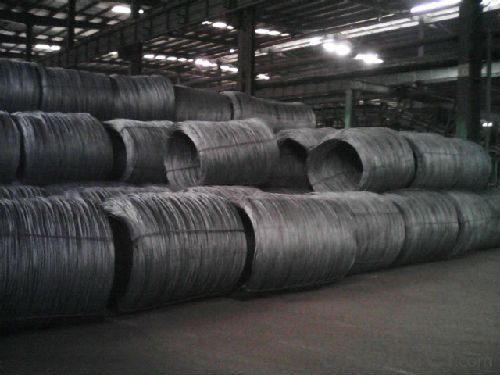
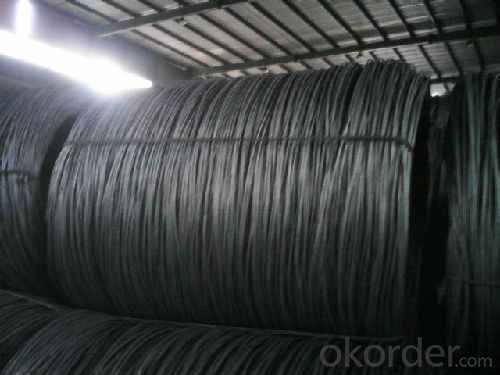

- Q:What are the common production processes for carbon steel wire rod?
- The common production processes for carbon steel wire rod include melting and refining of iron ore, casting of molten steel into billets, hot rolling of billets into wire rod coils, cooling and coiling of wire rod coils, and surface treatment processes such as pickling, phosphating, and coating for corrosion resistance.
- Q:What are the different types of defects that can occur in steel wire rod?
- There are several types of defects that can occur in steel wire rods, including surface defects such as scabs, scratches, and pits. Other common defects include internal defects like cracks, voids, and inclusions. It is essential to identify and address these defects to ensure the quality and reliability of the steel wire rod.
- Q:How is the decarburization of steel wire rod evaluated?
- Various methods and techniques are employed to evaluate the decarburization of steel wire rod, ensuring the final product's quality and properties. Visual inspection is a common evaluation method, whereby the wire rod's surface is carefully examined for signs of decarburization, such as discoloration or scaling. This preliminary assessment offers insights into the level of decarburization. Chemical analysis is also conducted to determine the carbon content at different depths of the wire rod. Samples are taken from various sections of the wire rod and subjected to carbon analysis tests. The results of this analysis reveal the extent of decarburization and aid in assessing its impact on the steel wire rod's mechanical properties. Microscopic examination is a crucial evaluation technique. Metallographic analysis involves preparing thin sections of the wire rod and observing them under a microscope. This allows for a detailed examination of the microstructure, facilitating the identification of any areas affected by decarburization. Specialized equipment, such as image analysis software, can be used to measure the depth and severity of decarburization. Moreover, mechanical testing is performed to evaluate the impact of decarburization on the wire rod's mechanical properties. Tensile strength, hardness, and ductility tests are commonly conducted to assess the wire rod's overall strength and behavior under different conditions. Any significant deviation from the desired mechanical properties may indicate a higher level of decarburization. In conclusion, the evaluation of decarburization in steel wire rod involves a combination of visual inspection, chemical analysis, microscopic examination, and mechanical testing. These techniques provide a comprehensive understanding of the extent and impact of decarburization, ensuring that the wire rod meets the required quality standards and specifications.
- Q:How is steel wire rod used in the manufacturing of wire for electrical cables?
- Steel wire rod is an essential raw material in the manufacturing of wire for electrical cables. The wire rod is first drawn through a series of dies to reduce its diameter and increase its length, resulting in a fine wire. This wire is then insulated with a non-conductive material, such as PVC or rubber, to create the electrical cable. The steel wire rod provides the necessary strength and conductivity to the wire, making it suitable for electrical applications.
- Q:How is the steel wire rod industry affected by government policies and regulations?
- The steel wire rod industry is significantly impacted by government policies and regulations. These policies and regulations can influence various aspects of the industry, including production, trade, pricing, and environmental standards. Governments may impose tariffs or quotas on steel wire rod imports to protect domestic producers, which can affect the competitiveness of the industry. Additionally, regulations related to labor, safety, and environmental standards can influence the operations and costs of steel wire rod producers. Government policies and regulations also play a crucial role in supporting the growth and development of the industry, such as providing incentives for research and development, infrastructure development, and promoting sustainable practices. Overall, the steel wire rod industry is highly dependent on government policies and regulations, which can shape its competitiveness, sustainability, and overall performance.
- Q:What are the different types of steel wire rod cooling methods?
- There are several different types of steel wire rod cooling methods, including air cooling, water cooling, and controlled cooling.
- Q:How is steel wire rod used in the manufacturing of wire rope slings for marine applications?
- Steel wire rod is a crucial component in the manufacturing of wire rope slings for marine applications. These slings are extensively used in various marine industries, including shipping, offshore oil and gas, and fishing. To begin with, steel wire rod serves as the raw material for wire rope slings. It is typically made from high-quality carbon or alloy steel, which ensures the strength and durability required for marine applications. The steel wire rod is usually produced in a continuous casting process, resulting in a long, cylindrical shape. Once the steel wire rod is obtained, it undergoes a series of manufacturing processes to transform it into wire rope slings. The first step involves drawing the steel wire rod through a die to reduce its diameter and increase its length. This process is repeated multiple times to achieve the desired wire diameter. The drawn wire is then cleaned to remove any impurities or surface contaminants. Next, the cleaned wire is twisted together to form strands. The number of strands can vary depending on the desired strength and load capacity of the wire rope sling. These strands are then tightly wound around a central core, which provides stability and support to the wire rope. The final step in the manufacturing process is the application of protective coatings to enhance the wire rope sling's resistance to corrosion and wear. Marine environments are highly corrosive due to the presence of saltwater, which can lead to the degradation of steel. Therefore, coatings such as galvanization or zinc plating are commonly applied to the wire rope to provide a barrier against corrosion. Once the steel wire rod has been transformed into a wire rope sling, it is ready for use in various marine applications. Wire rope slings are used for a wide range of purposes, including lifting heavy loads, securing cargo, and towing vessels. They are known for their high strength, flexibility, and resistance to abrasion, making them ideal for demanding marine environments. In conclusion, steel wire rod plays a vital role in the manufacturing of wire rope slings for marine applications. It serves as the raw material for wire rope production, undergoes various manufacturing processes, and is ultimately transformed into a strong and durable sling. Wire rope slings made from steel wire rod are essential tools in the marine industry, providing reliable and safe lifting and securing capabilities.
- Q:What are the common transportation methods for steel wire rod?
- The common transportation methods for steel wire rod include trucking, rail transportation, and shipping by sea or air.
- Q:Can steel wire rod be used in high-temperature applications?
- When using steel wire rod in high-temperature settings, careful consideration must be given to the specific type of steel and the temperatures involved. Some steel grades, like stainless steel or heat-resistant alloys, are specifically designed to maintain strength and structural integrity under high temperatures. These types of steel are commonly used in industries such as aerospace, automotive, and power generation, where exposure to high temperatures is frequent. However, it is important to note that not all steel wire rods are suitable for high-temperature applications. Lower-grade steels may experience a reduction in mechanical properties, such as tensile strength, ductility, and corrosion resistance, when exposed to elevated temperatures. To determine if a particular steel wire rod is suitable for a high-temperature environment, it is essential to refer to the manufacturer's specifications or seek expert advice. In addition to the type of steel, other factors should be considered when using steel wire rod in high-temperature applications. These include the operating conditions, duration of exposure, and the presence of corrosive elements or chemicals. Regular monitoring and maintenance may be necessary to ensure the ongoing performance and safety of the steel wire rod in these environments.
- Q:What are the main producers of steel wire rod?
- The main producers of steel wire rod are countries such as China, Japan, the United States, India, and Russia.
1. Manufacturer Overview |
|
|---|---|
| Location | |
| Year Established | |
| Annual Output Value | |
| Main Markets | |
| Company Certifications | |
2. Manufacturer Certificates |
|
|---|---|
| a) Certification Name | |
| Range | |
| Reference | |
| Validity Period | |
3. Manufacturer Capability |
|
|---|---|
| a)Trade Capacity | |
| Nearest Port | |
| Export Percentage | |
| No.of Employees in Trade Department | |
| Language Spoken: | |
| b)Factory Information | |
| Factory Size: | |
| No. of Production Lines | |
| Contract Manufacturing | |
| Product Price Range | |
Send your message to us
Carbon Steel Hot Rolled Wire Rod SAE1008 SAE1006 SAE1018
- Loading Port:
- Tianjin
- Payment Terms:
- TT or LC
- Min Order Qty:
- 50 m.t.
- Supply Capability:
- 40000 m.t./month
OKorder Service Pledge
OKorder Financial Service
Similar products
New products
Hot products
Hot Searches
Related keywords

